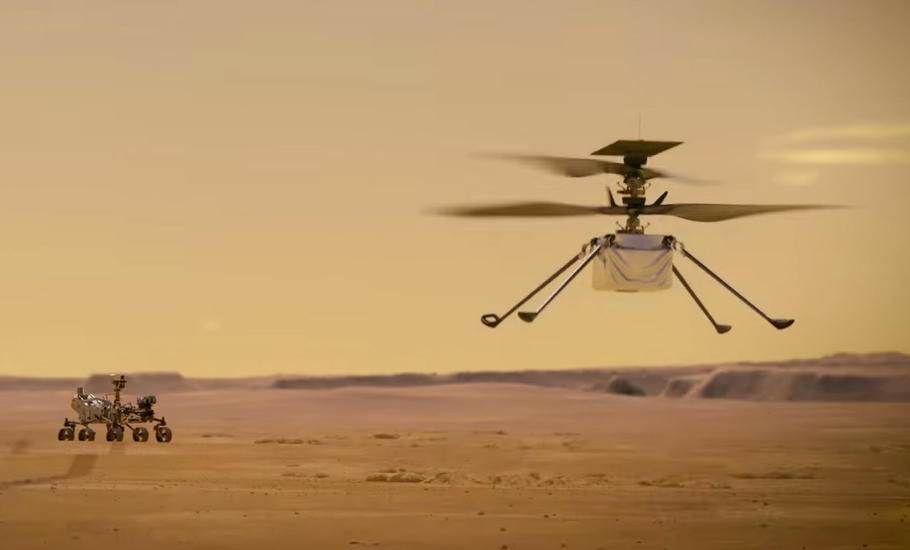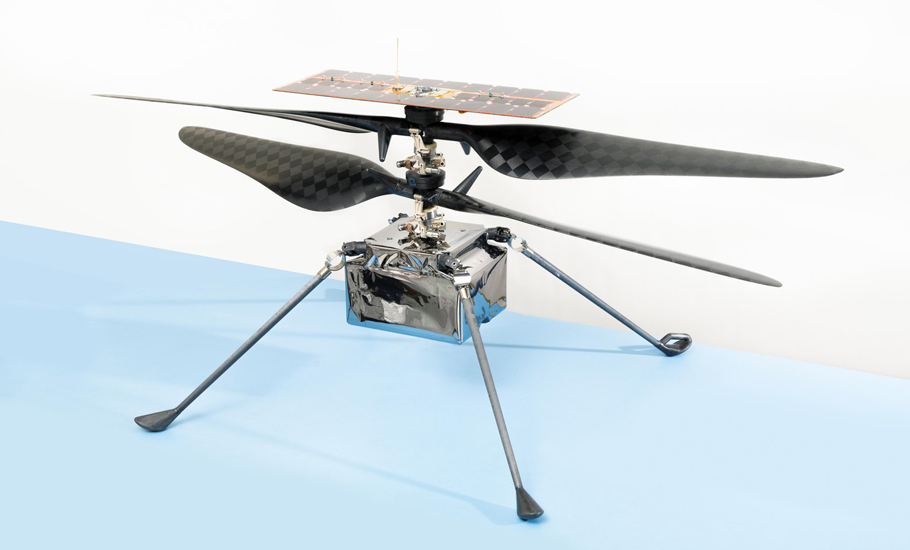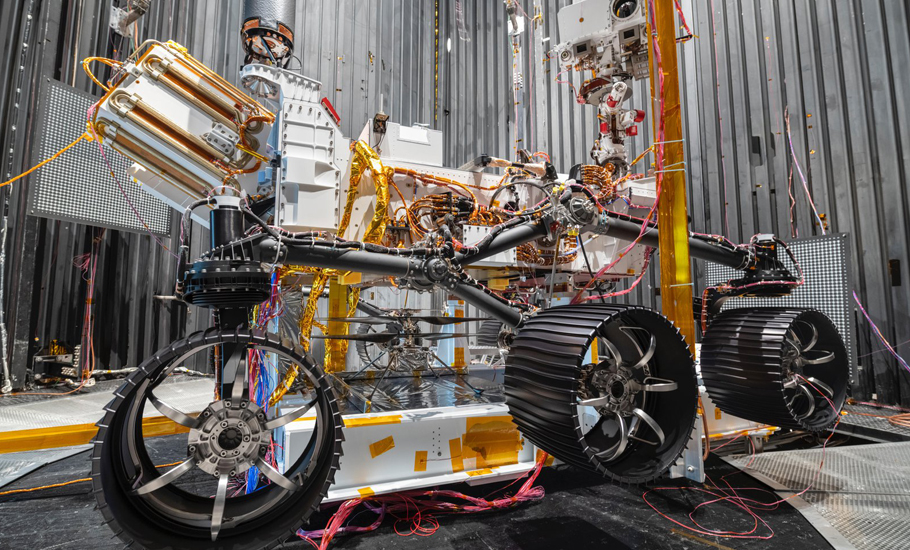
- Home
- News
- Analysis
- States
- Perspective
- Videos
- Education
- Entertainment
- Elections
- World Cup 2023
- Features
- Health
- Business
- Series
- Economy Series
- Earth Day
- Kashmir’s Frozen Turbulence
- India@75
- The legend of Ramjanmabhoomi
- Liberalisation@30
- How to tame a dragon
- Celebrating biodiversity
- Farm Matters
- 50 days of solitude
- Bringing Migrants Home
- Budget 2020
- Jharkhand Votes
- The Federal Investigates
- The Federal Impact
- Vanishing Sand
- Gandhi @ 150
- Andhra Today
- Field report
- Operation Gulmarg
- Pandemic @1 Mn in India
- The Federal Year-End
- The Zero Year
- Premium
- Science
- Brand studio
- Home
- NewsNews
- Analysis
- StatesStates
- PerspectivePerspective
- VideosVideos
- Entertainment
- ElectionsElections
- Sports
- Loading...
Sports - Features
- BusinessBusiness
- Premium
- Loading...
Premium

Why Ingenuity, the first helicopter to fly on another planet, is such a big deal

Nasa’s rover, Perseverance, successfully landed on the Jezero crater on Mars on February 18. Safely tucked under the probe’s belly, another engineering marvel called Ingenuity rode along the 200 million km journey to reach the planet. Ingenuity is a mini-helicopter that will deploy and make short flights on the red planet in the coming months. If successful, the aerial ventures are set...
Nasa’s rover, Perseverance, successfully landed on the Jezero crater on Mars on February 18. Safely tucked under the probe’s belly, another engineering marvel called Ingenuity rode along the 200 million km journey to reach the planet.
Ingenuity is a mini-helicopter that will deploy and make short flights on the red planet in the coming months. If successful, the aerial ventures are set to create space history as Ingenuity will be the first airborne vehicle to fly on another planet.
After surviving the rigours of space travel and the excruciating descent to the surface of Mars, Ingenuity called in on the ground engineers on February 20.
Nasa reports that the copter and its base station—an electrical contraption on the rover that will oversee the communications between Ingenuity and Earth—were both working as per expectations.
“With this positive report, we will move forward with the first stage of charge of the helicopter’s batteries,” stated the agency spokesperson.
Ingenuity will initially lie quietly in its position, testing its resilience to the frigid temperatures on the planet (-90 degrees Celsius). It will periodically charge its batteries and stay healthy for the next 30-60 days. After that, when suitable conditions prevail, the rover’s Mars Helicopter Delivery system will send the necessary deploy commands first to drop the debris cover, then unfold the copter’s insect-like landing legs.
The mini-helicopter will then gently plop on the surface.

From then on, Ingenuity will operate independently, while the rover will keep an eye on it from afar, with the Mars Helicopter Base Station’s help. Once deployed, Ingenuity will solar-power itself to thrive on Mars.
Perseverance will capture pictures of Ingenuity in action and transmit the collected data to earth.
What makes Ingenuity so marvellous
Ingenuity is the first-of-its-kind chopper, as flying on Mars is no mean task. On earth, helicopter rotor blades cut through atmospheric air, push it down to create the necessary airlift. A similar feat on Mars is challenging as the planet’s atmosphere is 99 times less dense than that of earth and does not provide adequate ‘lift’ for a chopper.
To overcome the hurdle, Ingenuity’s makers tweaked the design. They fitted it with four-feet long, counter-rotating rotor blades made from lightweight materials like foam and carbon fibre. The blades spin at high speeds of 2400 rpm to cut through the thin Martian atmosphere and generate the chopper’s airlift.
The entire copter module weighs less than 2-kilos. It takes advantage of the low-gravity of Mars so that the airlift is sufficient to hoist Ingenuity 10-15 feet above the ground.
Once off the ground, the chopper will be airborne for short durations of 90 seconds, gradually improving the distance and height with preliminary flights’ success. All along, Ingenuity will integrate the flight data and take independent decisions.
Another interesting aspect is Ingenuity is designed using a combination of specially designed components and off-the-shelf-consumer parts. For example, Ingenuity stores its power in standard lithium-ion batteries. It uses a smartphone Snapdragon Qualcomm Processor to run its computers.
https://youtu.be/UAScg8i45JI
Small yet mighty
Initially, the concept of adding a helicopter to the rover mission was not on Nasa’s cards. However, when it was conceptualised as a technology demonstration to ride along with Perseverance, the chopper was built in a record time of six years and on a stringent budget. Ingenuity will demonstrate that rotorcraft flight is achievable even in the thin atmosphere on Mars, though with a limited scope.
All of the copter-parts are tucked into a small cube made with specialised material called beryllium metal composite. The chopper passed rigorous ground-based tests and has proven its robustness until now.
What stands out is Ingenuity’s autonomous operation. The vast distances between the earth and Mars prevent real-time control of the chopper from the earth. Nor will the ground engineers have continuous access to the flight and engineering details. Therefore, Ingenuity will fend for itself, making vital navigation decisions while it hops around. A few sensors, an on-board camera and a programmable unit will guide Ingenuity’s five short flights and help it wield its way on the rocky Martian terrain.
One step at a time
Ingenuity’s makers at the Jet Propulsion Laboratory (JPL) are jubilant with the helicopter’s performance so far. They now cautiously approach the next steps of releasing the copter from Perseverance’s belly and safely on to the surface. Only after ascertaining continuous stability for 30 more days will they initiate its flight.

Impact on future missions
With Ingenuity’s success, new avenues will open for interplanetary missions. Future missions will send bigger and advanced robotic airborne vehicles. Engineers also envisage that such helicopters will become transport vehicles on other planets, carrying small but significant loads and astronauts from one region to another in the future.
The aerial dimension will add new scopes to surface exploration by overcoming several limitations of the land rovers. Future robotic missions will have the unique advantage of getting a bird’s eye view of planet surfaces, survey wider regions, explore hard-to-reach areas and crevices.
“We’ll be learning all along the way, and it will be the ultimate reward for our team to be able to add another dimension to the way we explore other worlds in the future,” stated MiMi Aung, Ingenuity’s Project Manager at JPL.

